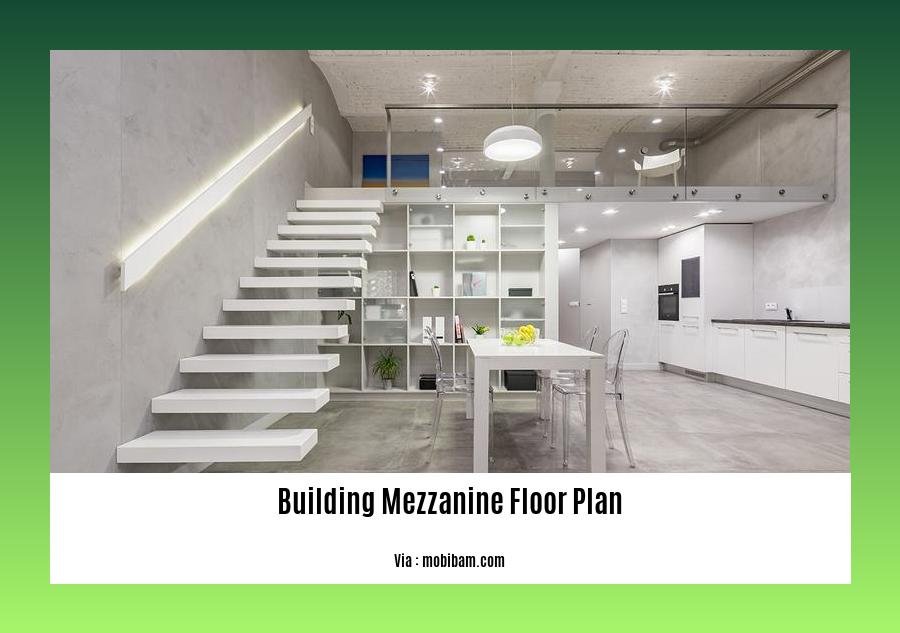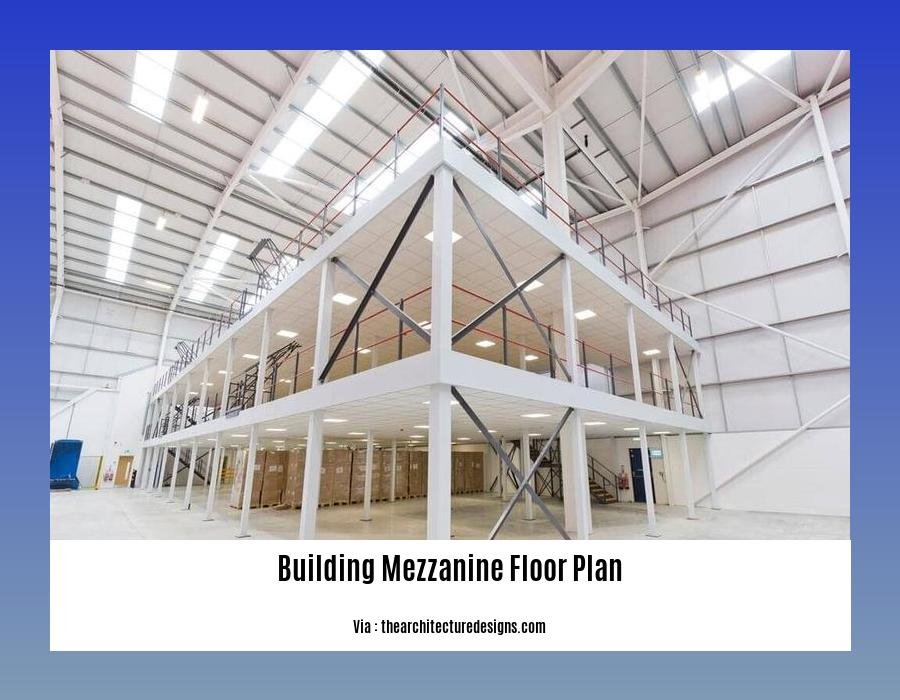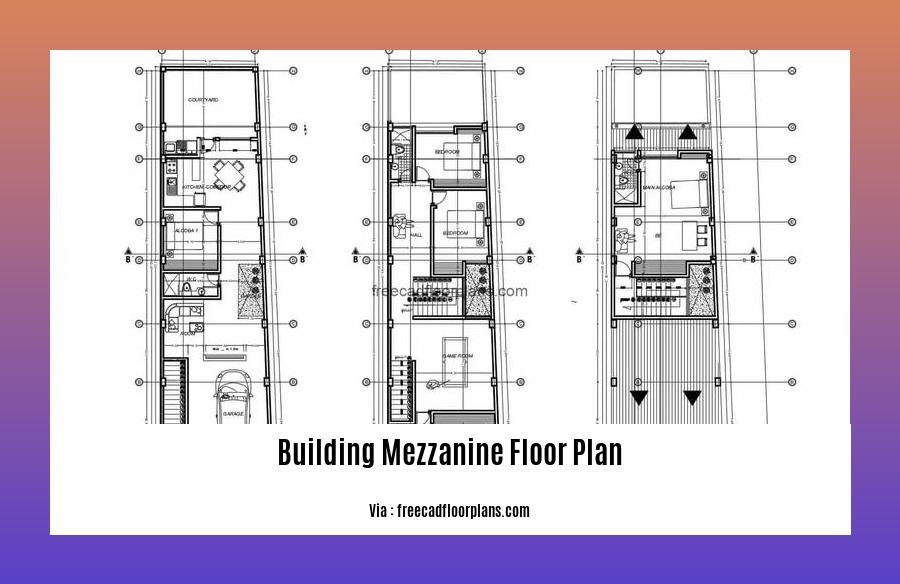Efficient and functional building mezzanine floor plans play a crucial role in enhancing productivity and optimizing space utilization for diverse businesses. With a focus on creating innovative and cost-effective solutions, experienced architects specializing in commercial building design bring their expertise to develop mezzanine floor plans that seamlessly combine creativity with practicality. By understanding customer needs and adhering to building regulations, these professionals ensure the creation of mezzanine layouts that not only enhance the aesthetic appeal of the space but also maximize usable space, allowing businesses to thrive and succeed in their industries.
Key Takeaways: Efficient and Functional Building Mezzanine Floor Plans: Enhancing Productivity and Space Utilization
- Mezzanine floors are a popular solution for maximizing space in offices and homes.
- Adding a mezzanine floor can effectively utilize available floorspace and optimize vertical space.
- Building a mezzanine floor involves steps such as measuring internal space, understanding floor design, and selecting appropriate steel materials.
- Mezzanine floors can be constructed using structural steel, seamlessly integrating with existing dimensions.
- It is crucial to determine the maximum height and clearance of the mezzanine level, considering desired headroom and steel frame thickness.
- Mezzanine floors have unique features like being constructed halfway up the wall and not counting as a full floor, providing increased floor space.
- Different types of mezzanine floor construction include free-standing, rack-supported, and shelving-supported.
- Mezzanine floors offer advantages such as additional storage space, flexible layout options, and increased property value.
- Compliance with building regulations and fire safety standards is essential when adding a mezzanine floor.
- Mezzanine floors can be a cost-effective solution for expanding usable area in offices and homes.
Building Mezzanine Floor Plan

A mezzanine floor is an ingenious solution for maximizing space in both offices and homes. It may initially seem like an attempt to cram two stories into a limited area, but when done right, a mezzanine floor can enhance productivity and space utilization, creating an efficient and functional space. In this guide, we’ll explore the steps involved in building a mezzanine floor and highlight the benefits it offers.
Measuring the Internal Space
Before embarking on a mezzanine floor project, it’s crucial to measure the internal space accurately. This step lays the foundation for the entire project. A thorough understanding of the available dimensions allows for optimal design and seamless integration of the mezzanine floor. By assessing the space carefully, you can ensure that every inch is utilized effectively.
Understanding the Floor Design
The floor design is a critical aspect of any mezzanine floor plan. It determines the overall layout and functionality of the space. When creating your mezzanine floor plan, consider factors such as the purpose of the space, the desired headroom, and the flow of movement. By carefully analyzing these elements, you can design a mezzanine floor that aligns perfectly with your needs and enhances overall productivity.
Checking the Steel Materials
Structural steel is commonly used in mezzanine floor construction due to its durability and versatility. The steel materials play a vital role in the stability and strength of the mezzanine floor. Before embarking on the construction phase, it’s crucial to carefully check and verify all steel materials for quality and suitability. This ensures a seamless integration of the mezzanine floor within the existing space.
Determining Maximum Height and Clearance
The maximum height and clearance of the mezzanine floor should be determined early in the planning phase. Consider the desired headroom and the thickness of the steel frame to ensure there is ample clearance for comfort and safety. The goal is to create a mezzanine level that feels spacious and open while adhering to structural integrity.
Different Types of Mezzanine Floor Construction
There are various types of mezzanine floor construction, each suited to different needs and spaces. Understanding the options available will help you make an informed decision for your project. Some common types include free-standing, rack-supported, and shelving-supported mezzanine floors. Each type offers unique advantages and considerations, so it’s essential to assess which one aligns best with your requirements.
Advantages of Mezzanine Floors
Mezzanine floors offer numerous advantages that make them an attractive option for expanding usable space. Here are a few key benefits to consider:
-
Additional Storage Space: A mezzanine floor provides valuable additional storage space, allowing you to make the most of the vertical height in a room.
-
Flexible Layout: The modular nature of mezzanine floors allows for flexibility in layout and future modifications. You can easily reconfigure the space to adapt to changing needs.
-
Increased Property Value: Adding a mezzanine floor increases the overall value of your property. It enhances the appeal and functionality of the space, making it more attractive to potential buyers or tenants.
Building Regulations and Fire Safety
When adding a mezzanine floor, it’s crucial to consider building regulations and fire safety requirements. Depending on your location, there may be specific restrictions and guidelines to follow. Ensuring compliance with these regulations is essential to guarantee the safety and legality of the project. Consult with a professional architect or engineer to navigate through the complexities and ensure a smooth and compliant construction process.
Cost-Effective Solutions
Mezzanine floors offer cost-effective solutions for expanding usable area in offices and homes. By utilizing vertical space efficiently, you can avoid the need for expensive renovations or relocating to larger premises. Mezzanine floors are a practical and budget-friendly option for maximizing space and enhancing productivity.
In conclusion, creating an efficient and functional mezzanine floor plan requires careful planning, understanding of building regulations, and expertise in maximizing space utilization. By following the steps outlined in this guide and considering the advantages offered by mezzanine floors, you can enhance productivity and transform your space into a dynamic and efficient environment. Start exploring the possibilities of mezzanine floors today and unlock the true potential of your space.
Sources:
ArchDaily – Maximizing Space with Mezzanine Levels in Offices and Homes
Excalibur Steel Buildings – How to Build a Mezzanine Floor – Mezzanine Floors Made Easy
To learn about building mezzanine floor height regulations, click here.
If you’re curious about the meaning of building a mezzanine floor, check out this informative article here.
Planning to construct a mezzanine floor? Make sure to familiarize yourself with the necessary building mezzanine floor planning permission by clicking here.
Stay up to date with building mezzanine floor regulations by visiting here.
Ensure your building mezzanine floor has proper structural design by referring to this helpful resource here.
Designing an Efficient and Functional Mezzanine Floor Plan

Mezzanine floors have become a popular solution for maximizing space in both commercial and residential settings. Whether you’re looking to create additional storage space, a sitting area, or even an office, a well-designed mezzanine floor plan can greatly enhance the functionality of your space. In this instructional guide, we will explore the key considerations and steps involved in designing an efficient and functional mezzanine floor plan.
Understanding the Purpose and Space Dimensions
Before embarking on a mezzanine floor project, it is crucial to accurately measure the internal space and understand its specific purpose. Ask yourself, what do you intend to use the mezzanine floor for? Will it be a storage area, an office, or maybe a library? By clearly defining the purpose, you can tailor the design to suit your unique needs.
Maximizing Space Utilization with the Right Layout
Designing the floor layout is another important aspect to consider. It should take into account the desired headroom, flow of movement, and overall aesthetic appeal. Think about how you want to utilize the space and ensure that the layout supports your intended activities. By carefully planning the layout, you can ensure optimal space utilization and create a functional mezzanine floor plan.
Selecting the Right Materials for Construction
When it comes to constructing a mezzanine floor, choosing the right materials is essential. Structural steel is a popular option due to its strength, durability, and versatility. It can blend seamlessly with the existing space and provide the necessary support for your mezzanine floor. Consider factors such as load-bearing capacity and fire resistance when selecting materials for your construction.
Ensuring Adequate Height and Clearance
Determining the maximum height and clearance required for your mezzanine floor is crucial. This will depend on the activities that will take place on the floor, as well as any regulations or restrictions in your area. By determining these measurements early in the planning phase, you can avoid any costly modifications or design changes later on.
Incorporating Flexibility and Adaptability
Mezzanine floors offer endless possibilities for versatility and adaptability. Consider designing your floor to be multifunctional, allowing for different activities to take place in the same space. This can be achieved by incorporating modular furniture, movable partitions, or flexible storage solutions. By designing a flexible mezzanine floor plan, you can easily adapt to changing needs and maximize the functionality of your space.
Cost Considerations
It’s important to keep in mind that the cost of a mezzanine floor can vary depending on various factors. These factors include the materials used, the complexity of the design, and any additional features or customizations. By carefully considering your budget and working with a professional architect or contractor, you can design a mezzanine floor plan that meets your needs while staying within your financial constraints.
Key Takeaways:
- Accurately measure the internal space and define the purpose for your mezzanine floor.
- Design the floor layout to optimize space utilization and support the intended activities.
- Choose materials such as structural steel that provide strength and durability.
- Determine the maximum height and clearance required early in the planning phase.
- Incorporate flexibility and adaptability to accommodate different activities.
- Consider the cost factors and seek professional guidance to stay within budget.
Sources:
– Excalibur Steel Buildings. “How to Build a Mezzanine Floor – Mezzanine Floors Made Easy.” Website
– Indonesia Design. “10 Brilliant Mezzanine Designs and Uses (2020).” Website
Considering Building Regulations and Safety Standards
Building a mezzanine floor requires careful consideration of building regulations and safety standards to ensure structural integrity and the safety of occupants. Compliance with these regulations is essential to meet national and state-based building requirements. In this article, we will explore the key aspects of building regulations and safety standards that should be considered when designing efficient and functional mezzanine floor plans.
Structural Safety and Verification
The first and foremost aspect of building regulations for mezzanine floors is structural safety. Mezzanine floor designs must adhere to specific structural integrity requirements and associated calculations. Verification of these calculations is necessary to ensure that the structure can safely support the intended loads and occupancy. By considering these building regulations, architects and designers can create mezzanine floor plans that guarantee the safety and stability of the structure.
Fire Safety Measures
Fire safety is another crucial aspect of mezzanine floor building regulations. It is essential to incorporate measures that comply with fire safety standards, including means of warning and escape and using fire-resistant materials. By integrating appropriate fire safety measures into the design, mezzanine floors can effectively prevent the spread of fire and facilitate safe evacuation in case of emergencies.
Protection Against Falling and Accessibility
To ensure the safety of occupants, mezzanine floor regulations also cover protection against falling. Protective barriers, such as guardrails or handrails, must be installed to prevent accidents and falls from elevated platforms. Additionally, accessibility requirements should be considered to ensure that the mezzanine floor can be safely accessed by all individuals, including those with disabilities. By adhering to these regulations, architects can create mezzanine floor plans that prioritize the safety and accessibility of the space.
Compliance with Codes and Standards
Compliance with relevant codes and standards is paramount when constructing mezzanine floors. In Australia, specific codes and standards need to be followed to ensure the safety and compliance of mezzanine floors. Partnering with a reputable company that specializes in mezzanine floor construction, such as Hi-Level, can help architects and designers ensure compliance with current building regulations, quality standards, best practice guidance, and fire regulations.
Key Takeaways:
- Building regulations for mezzanine floors prioritize structural safety and require verification of structural integrity and associated calculations.
- Mezzanine floor regulations also cover fire safety measures, protection against falling, and accessibility requirements.
- Compliance with relevant codes and standards ensures the safety and compliance of mezzanine floors.
- Partnering with reputable companies specializing in mezzanine floor construction can help ensure compliance with building regulations, quality standards, and fire regulations.
Sources:
1. Nexus Workspace: Mezzanine Floor Building Regulations: What You Need To Know
2. Stodec: Mezzanine Floor Building Regulations & Requirements
Efficient and Functional Building Mezzanine Floor Plans: Enhancing Productivity and Space Utilization
Adding a mezzanine floor to a commercial building can significantly enhance productivity and maximize usable space. With the right approach, businesses can optimize their mezzanine floor plans to meet their unique needs and requirements. In this article, we will explore the key considerations and strategies for optimizing the mezzanine floor plan for different business needs.
Understanding Business Needs
When designing a mezzanine floor plan, it is crucial to understand the specific requirements of the business. Consider factors such as the type of business operations, workflow, and space utilization goals. This understanding will guide the layout and design process, ensuring that the mezzanine floor plan meets the business’s needs effectively.
Space Utilization and Efficiency
Efficient use of space is a fundamental aspect of optimizing a mezzanine floor plan. Businesses should carefully assess their current and future space requirements. By analyzing the available space, businesses can determine the most effective way to utilize the mezzanine floor. This could involve considering storage racks, workstations, or designated areas for specific activities.
To maximize efficiency, businesses should also evaluate the flow of movement within the mezzanine area. A well-designed layout should promote smooth and seamless movement, minimizing congestion and potential bottlenecks.
Flexibility and Adaptability
Businesses often need the ability to adapt their space as their needs evolve. A mezzanine floor plan should factor in this need for flexibility. By incorporating modular components or demountable partitions, businesses can easily reconfigure the space without significant disruptions.
Additionally, consider the future growth of the business. Designing the mezzanine floor plan to accommodate potential expansions or additional functionalities will save time and money in the long run.
Safety and Compliance
Creating a safe environment within the mezzanine floor is of utmost importance. Businesses must comply with building regulations and safety standards to ensure the well-being of employees and visitors. Factors to consider include proper access points, sufficient lighting, and fire safety measures.
Consulting with professionals who have expertise in mezzanine floor design and building regulations is highly recommended. They can provide guidance on compliance and help create a safe and secure working environment.
Expert Consultation and Collaboration
Optimizing a mezzanine floor plan for different business needs requires collaboration between business owners, architects, and structural engineers. Each party brings their unique expertise and perspectives to the project, ensuring the final design aligns with the business’s goals and requirements.
Engaging professionals who specialize in mezzanine floor design and have a proven track record in creating efficient layouts is crucial. Their experience and knowledge will help businesses achieve optimal space utilization and functionality.
Key Takeaways:
- Understand the specific requirements and goals of your business when designing a mezzanine floor plan.
- Efficient space utilization is essential for maximizing the benefits of a mezzanine floor.
- Flexibility and adaptability should be built into the design to accommodate future changes.
- Be cognizant of safety regulations and ensure compliance with building codes.
- Collaboration with experienced professionals in mezzanine floor design is crucial for success.
Sources:
- Graana.com – Mezzanine Floors: A Comprehensive Guide
- The Constructor – Mezzanine Floor for Buildings: Important Features and Types
FAQ
Q1: What is a mezzanine floor plan?
A1: A mezzanine floor plan is a design layout that incorporates an additional level within a building, creating additional usable space above the ground floor or main level.
Q2: What are the benefits of utilizing a mezzanine floor plan?
A2: Mezzanine floor plans offer several benefits, including maximizing space utilization, providing flexibility for various activities or functions, and increasing the overall value of the property.
Q3: How are mezzanine floor plans designed to enhance productivity?
A3: Mezzanine floor plans are designed to optimize space and create efficient layouts that enhance productivity. They can be customized to accommodate specific needs, such as additional storage areas, sitting areas, offices, or libraries, which can improve workflow and organization in a building.
Q4: Are there specific regulations to consider when designing a mezzanine floor plan?
A4: Yes, it is important to consider building regulations and fire safety requirements when designing a mezzanine floor plan. These regulations ensure structural safety, protection against falls, accessibility, and compliance with national and state-based building requirements.
Q5: How can a mezzanine floor plan be cost-effective?
A5: Mezzanine floor plans can be a cost-effective solution for expanding usable area in offices and homes. By utilizing the existing vertical space within a building, mezzanine floors avoid the need for expensive construction projects or acquiring additional property.
- Embossed Backsplash Tile Kitchen: Add Texture And Style - December 22, 2025
- Ceramic Tile Backsplash Ideas for Your Kitchen Remodel - December 21, 2025
- Contemporary Kitchen Backsplash Ideas for a Stylish Home - December 20, 2025










